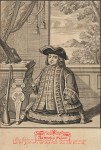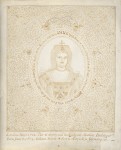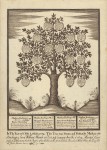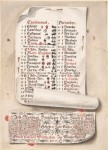The art of micrography, drawings composed of lines of text so miniscule they are all but unreadable to the naked eye, is a traditional Jewish artform developed in the 9th century. One of its greatest masters did it without hands.
 Matthias Buchinger was born on June 3rd, 1674, in a town near Nuremberg. He had no arms below the elbows and no legs below his upper thighs. According to an 1833 article in The Dublin Penny Journal that cites the nephew of a friend of Buchinger’s, his parents were “distressed at his unnatural form” and “concealed him as much as possible.” Other than that there’s a record of an unnamed individual matching his description at a fair sideshow in Leipzig in 1694. His first concrete entrance in the historical record comes in the first decade of the 18th century with his earliest surviving artworks.
Matthias Buchinger was born on June 3rd, 1674, in a town near Nuremberg. He had no arms below the elbows and no legs below his upper thighs. According to an 1833 article in The Dublin Penny Journal that cites the nephew of a friend of Buchinger’s, his parents were “distressed at his unnatural form” and “concealed him as much as possible.” Other than that there’s a record of an unnamed individual matching his description at a fair sideshow in Leipzig in 1694. His first concrete entrance in the historical record comes in the first decade of the 18th century with his earliest surviving artworks.
 By then he was in his 30s and was 29 inches tall. He was also a polymath genius, accomplished not just in calligraphy and drawing, but in playing multiple musical instruments, sleight-of-hand (minus hands), creating miniatures in bottles, carving wood, threading a needle, shooting and bowling, all accomplished by the dextrous use of small fin-like appendages at the ends of his arm stumps. Buchinger traveled all over Europe, from Augsburg to Amsterdam to Paris to Copenhagen to London to Belfast, displaying his many talents and tricks to amazed crowds and crowned heads alike. Poetry was written about “the Little Man of Nuremberg.”
By then he was in his 30s and was 29 inches tall. He was also a polymath genius, accomplished not just in calligraphy and drawing, but in playing multiple musical instruments, sleight-of-hand (minus hands), creating miniatures in bottles, carving wood, threading a needle, shooting and bowling, all accomplished by the dextrous use of small fin-like appendages at the ends of his arm stumps. Buchinger traveled all over Europe, from Augsburg to Amsterdam to Paris to Copenhagen to London to Belfast, displaying his many talents and tricks to amazed crowds and crowned heads alike. Poetry was written about “the Little Man of Nuremberg.”
Nobody could do him as much justice as he did himself. Here’s how he described himself in a 1724 engraving publicizing his performances.
“This is the effigies of Mr. Matthew Buchinger, being drawn and written by himself he is the wonderful little man of but 29.inches high, born without hands, feet, of thighs, June the 2. 1674. in Germany, in the Marquisate of Brandeburgh, near to Nurenburgh. He being the last of nine children, by one father and mother, viz. eight sons, and one daughter. The same little man has been married four times, and has had issue eleven children, viz. one by his first wife, three by the second, six by his third, and one by his present wife. This little man performs such wonders as have never been done by any; but himself. He plays on various sorts of music to admiration, as the hautboy, strange flute in consort with the bagpipe, dulcimer and trumpet; and designs to make machines to play on almost all sorts of music. He is no less eminent for writing, drawing of coats of arms, and pictures to the life, with a pen. He also plays at cards and dice, performs tricks with cups and balls, corn and live birds; and plays at skittles or nine-pins to a great nicety, with several other performances, to the great satisfaction of all spectators.”
Notice that his self portrait in that engraving is a micrograph. The curls of his peruke contain the complete 27th, 121st, 128th, 130th, 140th, 149th, and 150th Psalms, plus the Lord’s Prayer.
 Buchinger wasn’t just tooting his own horn to draw an audience, either. Eyewitness reports matched his account. Here’s a review from James Paris, who saw him in London on March 10th, 1731:
Buchinger wasn’t just tooting his own horn to draw an audience, either. Eyewitness reports matched his account. Here’s a review from James Paris, who saw him in London on March 10th, 1731:
“He did with his stumps what many could not do with their hands and feet so well as he in playing at cards, dice, ninepins, shuffel-board and roily-poly. He did cutt paper in several curious shapes, forms and figures. He writ, cast accounts, and designed very prettily; comb’d, oyl’d and powdered his perruque very well; load and discharge a pistol and did never fail of hitting the mark. He darted a sword at a mark exactly at a great distance and performed a great many other strange things.”
 Said spectators included three successive German emperors and one king of Britain. He moved to England from Hanover in 1717, three years after the Elector of Hanover became King George I. Hoping to secure a lucrative appointment from the new king, he presented him with an instrument of his own invention. King George gave him a nice prize of 20 guineas, but no job, so he kept moving. He traveled through England, Scotland and Ireland, finally settling in County Cork. By the time of his death in County Cork in 1739, Buchinger was a wealthy man. He left behind a widow and at least 14 legitimate children. He was reputed to have had 70 mistresses and dozens of illegitimate children.
Said spectators included three successive German emperors and one king of Britain. He moved to England from Hanover in 1717, three years after the Elector of Hanover became King George I. Hoping to secure a lucrative appointment from the new king, he presented him with an instrument of his own invention. King George gave him a nice prize of 20 guineas, but no job, so he kept moving. He traveled through England, Scotland and Ireland, finally settling in County Cork. By the time of his death in County Cork in 1739, Buchinger was a wealthy man. He left behind a widow and at least 14 legitimate children. He was reputed to have had 70 mistresses and dozens of illegitimate children.
 Sixteen of his drawings are now on display in Wordplay: Matthias Buchinger’s Drawings from the Collection of Ricky Jay, an exhibition at the Metropolitan Museum of Art in New York. Magnifying glasses are available so visitors can attempt to read the miniscule calligraphy. Even magnified it’s still almost impossible to read. How he managed to write such tiny letters without the aid of a magnifying device of his own (and we know he didn’t use them because he drew so many pieces in front of an audience) is still a mystery today.
Sixteen of his drawings are now on display in Wordplay: Matthias Buchinger’s Drawings from the Collection of Ricky Jay, an exhibition at the Metropolitan Museum of Art in New York. Magnifying glasses are available so visitors can attempt to read the miniscule calligraphy. Even magnified it’s still almost impossible to read. How he managed to write such tiny letters without the aid of a magnifying device of his own (and we know he didn’t use them because he drew so many pieces in front of an audience) is still a mystery today.
 As a renown master of sleight-of-hand and collector of historical marvels, Ricky Jay has been fascinated by Buchinger’s talent and bravado for three decades. Most of the Buchinger drawings in the exhibition are on loan from Jay’s collection. Buchinger’s work is joined by his other masters of micrography, including a portrait of Martin Luther by Johann Michael Püchler, who worked in Nuremberg when Buchinger was young and who may have taught him but certainly inspired him. The exhibition brings the art of lettering into the modern era with pieces by Jasper Johns and other contemporary artists. It runs through April 11th, 2016.
As a renown master of sleight-of-hand and collector of historical marvels, Ricky Jay has been fascinated by Buchinger’s talent and bravado for three decades. Most of the Buchinger drawings in the exhibition are on loan from Jay’s collection. Buchinger’s work is joined by his other masters of micrography, including a portrait of Martin Luther by Johann Michael Püchler, who worked in Nuremberg when Buchinger was young and who may have taught him but certainly inspired him. The exhibition brings the art of lettering into the modern era with pieces by Jasper Johns and other contemporary artists. It runs through April 11th, 2016.